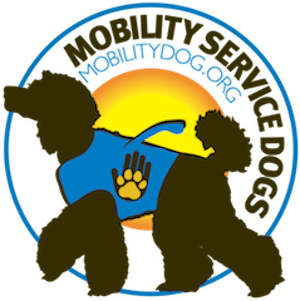Why a Service Dog?
Woman in Wheelchair with Black Dog
Service dogs have been depicted as far back as ancient Rome in 1st Century frescos of dogs leading blind men. The same can be seen in 13th Century Chinese scrolls.
But why a Service Dog?
Service Dogs in History
Canines have helped mankind from almost the beginning of time! For food, protection, hunting and companionship, these dogs have seamlessly integrated themselves into our lives over the centuries.
13th Century Chinese Artwork Showing a Blind Man being Led by a Dog (Courtesy: Hovawart.chienguide.free.fr)
From the 1st Century AD in Rome up to the Middle Ages in Asia and Europe, these early dogs lead blind men.
In 1788, a Parisian hospital formally began to train dogs to aid the visually challenged.
In 1819, the Institute for the Education of the Blind was founded in Vienna with a special method for training early Guide Dogs.
During WWI with many soldiers being blinded on the battlefield, a German doctor set out to train a larger number of guide dogs to help these soldiers.
In 1928 in America, Buddy and Morris Frank, his blind owner, demonstrated safely navigating a New York intersection. This eventually led to the creation of The Seeing Eye, the first American Guide Dog School.
In the 1960s, service dogs began to help more people beyond those who were blind. Bonnie Bergin is credited with the modern-day service dog concept in the 1970s.
And finally, in 1990, the Americans with Disabilities Act (ADA) formally laid out the legal rights of service dogs and the protection against discrimination based on disabilities.
Finally, the disabled community possessed the legal right and freedom to live their day-to-day life with the support of service dogs.
The Common Thread
White Poodle Service Dog
Throughout history, these special dogs were trained to help those with disabilities that disrupted their daily life and freedom. Since dogs helped mankind from almost the beginning of time, it was a natural progression to train these incredible canines to assist those who needed their help in navigating the world.
Finally, those challenged with different kinds of disabilities had a new “tool” in regaining their freedom in their life and in public. The ADA law allows the disabled handler and their trained service dog to access any place open to the general public including public transportation, restaurants, hotels, housing, event venues and more.
As society as a whole becomes more knowledgeable and accepting of what it means to be “disabled,” service dogs are being trained to assist with more physical handicaps.
Why a Service Dog?
Poodle Service Dog with Disabled Handler
According to the AKC, a service dog is “trained to take a specific action that helps mitigate an individual’s disability.” People challenged with physical disabilities may find daily tasks difficult or even impossible without proper support.
In addition, for some disabilities, there may be few medications or medical devices that can positively overcome a physical disability. But service dogs offer an ever-evolving option for successfully addressing physical hardships.
Service dogs can also support their disabled handlers in ways many other medical “solutions” cannot. Canines are capable of calming people down, reducing blood pressure, stress levels and even depression. They also offer non-judgmental support, companionship and comfort. These are all priceless benefits, especially for those who find themselves alone and without a human support network on a daily basis.
Bless these incredible dogs and their ongoing contributions to the disabled community!
All Images Courtesy of MobilityDog.org





